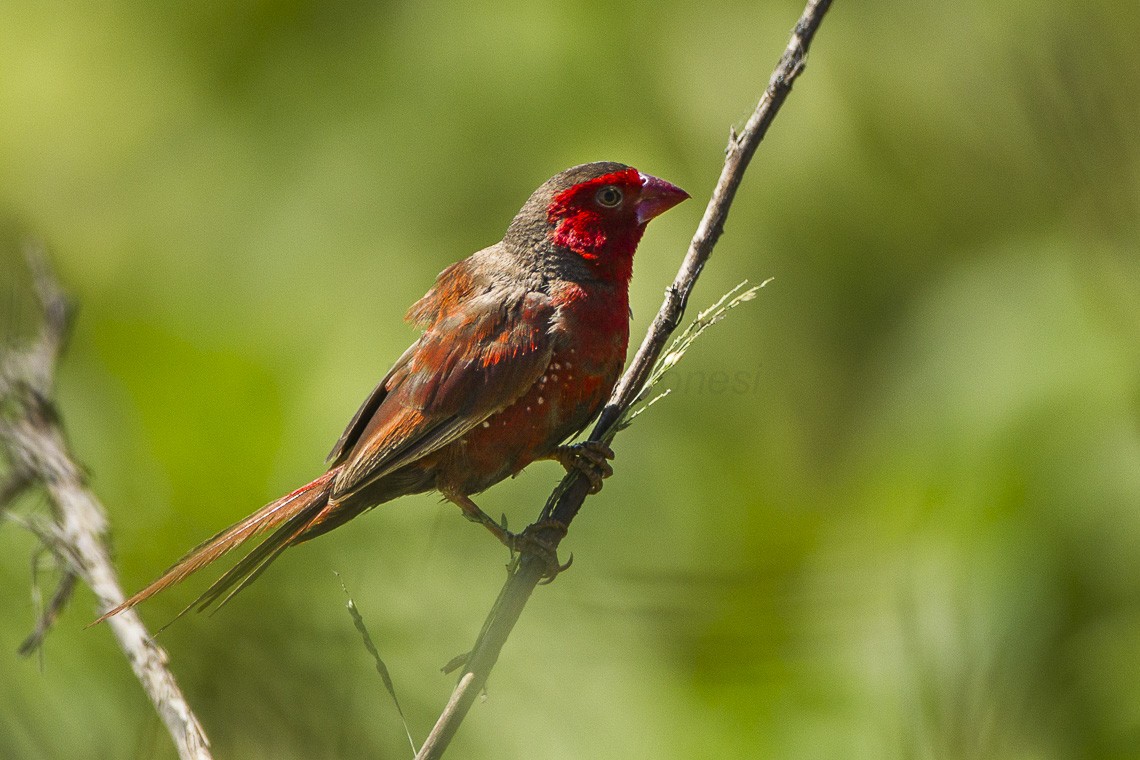Crimson Finch
A species of Finch Scientific name : Neochmia phaeton Genus : Finch
Crimson Finch, A species of Finch
Botanical name: Neochmia phaeton
Genus: Finch
Content
Description General Info
 Photo By Francesco Veronesi , used under CC-BY-SA-2.0 /Cropped and compressed from original
Photo By Francesco Veronesi , used under CC-BY-SA-2.0 /Cropped and compressed from original Description
The crimson finch is a relatively small-sized bird. It is about 13 cm in length and weighs just 13g (0.46 oz). Standout features include a bright crimson color, long tail, and white specks that run across the sides of its body. There are also shades of grey around the neck area. This species is sexually dimorphic as the females are slightly paler in color. However, the same plumage is observed for both sexes. A difference between males and females is that males have longer tails and bills. In addition, they are larger and heavier. Three weeks after fledging, crimson finches moult into adult plumage. The moult is only partial as juvenile greater primary coverts are preserved. 
Size
13 cm
Nest Placement
Shrub
Feeding Habits
Crimson Finch primarily consumes seeds from various grasses such as Panicum and Themeda. It also integrates insects, termites, spiders, and green algae into its diet. Crimson Finch forages in vegetation and on the ground, skillfully picking seeds directly from seedheads and capturing insects in flight. Its unique diet includes lerp from Psyllidae. Crimson Finch typically forages in pairs or groups, occasionally joining larger flocks or other estrildids.
Habitat
Crimson Finch are typically found in wetland environments, favoring areas with dense vegetation such as tall grasses, reeds, and the vicinity of Pandanus trees. They thrive in a mix of semi-arid to marshy grasslands and savannas, and are also present in bamboo thickets and occasionally cultivated lands like rice fields. These birds prefer lowland habitats and often utilize shrubs and dry brush, as well as hollows in tree limbs, for nesting purposes.
Dite type
Granivorous
General Info
Feeding Habits
Bird food type
Behavior
Crimson finches are renowned for their aggressive behavior; hence the nicknames “blood finch” and “killer finch”. Males are aggressive towards birds of the same species as well as different species. In any case, there is no consideration of age, coloration, or body size. Aggressive encounters are largely held on an individual basis and thus vary. Female crimson finches also exhibit similar aggressive behavior towards intruders if they are the primary defenders of a nest. However, little is known about female aggression. For breeding, crimson finches’ primary mating system is monogamy. There are about 4 to 5 breeding pairs per 100 meters. They are known to be non-territorial and establish nests in close proximity to other birds’ nests. They primarily nest in areas that are centrally located to riparian vegetation and rivers. Unlike other southern passerines that lay small clutches, crimson finches have extremely large clutch sizes. This deviance could be explained by high rates of nest predation by reptiles, which use their olfactory sense to find nests. For feeding, crimson finches primarily feed on seeds of grasses. One example is Xerochloa imberbis, a type of rice grass. They also feed on insects. Crimson finches have high survival rates (70-96%). They can live up to 5 years and beyond. 
Distribution Area
Crimson finches are mainly distributed across Northern Australia with some residing in New Guinea. They are common in the Kimberley (Northwest) region but less widespread in the Queensland (Northeast) area. Crimson finches’ preferred habitats are areas with tall, dense grasses. They typically reside near wetlands (riparian vegetation) that have an abundance of Pandanus trees. For nesting, they utilize shrubs and dry brush to establish nests at the base of Pandanus trees. Nests are also commonly established within hollow tree limbs. 
Species Status
According to the IUCN Red List, the crimson finch is classified as "least concern" The current population is stable and doesn't see any substantial threats. However, their habitat has been vulnerable due to floods caused by dam construction. Despite this, they have adapted and have yet to encounter any significant problems as indicated by their unaffected nesting and breeding success. 
Scientific Classification
Phylum
Chordates Class
Birds Order
Perching birds Family
Estrildid finches Genus
Finch Species
Crimson Finch